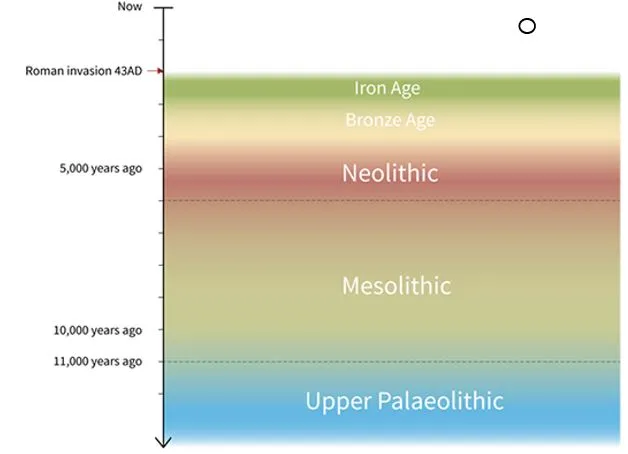| The Stone Age (6,000-4,000 BP (Before Present))
Stone Age was a long prehistoric period characterised by the use of stone tools. It started about 2.5 million years ago with the arrival of the early humans (‘Homo Habilis’ and Australopithecus). The Stone Age is separated into three additional categories:
- Paleolithic (Old Stone Age): It dated from 2.5 million years ago to 12,000 years ago. It is characterised by the use of rudimentary stone tools, and a hunter-gatherer lifestyle
- Key Innovations: Transition from crude pebble tools to advanced handaxes; control of fire around 1 million years ago was pivotal for human progress.
- Important sites in India- Bhimbhetka, Belan, Chota Nagpur plateau (Bihar), Renigunta in Chittoor and Kurnool, Muchchatla Chintamani Gavi (Andhra Pradesh) and Imamgaon (Maharashtra).
- Mesolithic (Middle Stone Age): It spanned roughly from 20,000 to 10,000 B.C.E., varying by region.
- Characteristics: Notable for the rise of pottery, peak hunter-gatherer cultures, and the beginnings of permanent settlements.
- Important sites in India- Adamgarh(M.P) and Bagor in Rajasthan – earliest domestication of animals. Bhimbetka caves (Madhya Pradesh), Kharwar, Jaora and Kathotia (M.P), Sundargarh and Sambalpur (Odisha), Ezhuthu Guha (Kerala). Langhnaj (Gujarat), Sarai-Nahar-Rai (Pratapgarh U.P), Paisara(Munger Bihar).
- Neolithic (New Stone Age): It began around 10,000 B.C.E., marked by the agricultural revolution.
- Impact: Farming enabled permanent settlements and laid the foundation for organized societies, particularly flourishing in the Fertile Crescent and spreading to Europe, Africa, and Asia.
- Important sites in India- Burzahom, Gufkral, Chirand, Piklihal, Brahmagiri, Maski, Takkalakota, HallurKoldihwa and Mahagara
- The Stone Age was followed by the Bronze Age which began around the year 2300 BC.

Mesolithic Period
- The Mesolithic Age is the period of time between the Palaeolithic Age and the Neolithic Age. The exact beginning of this part of the Stone Age varies from region to region
- Characteristics:
- Transition from hunter-gatherer societies to more settled lifestyles.
- Development of microliths (small stone tools) for hunting and gathering.
- Use of natural resources and early forms of domestication.
- Emergence of semi-permanent settlements near water sources.
- Tools in the Mesolithic Age: The Mesolithic Age is characterized by a significant advancement in tool technology compared to the earlier Palaeolithic era. Here are the primary tools from this period:
- Points: Sharp, pointed tools often used for making spears. It was essential for hunting and fishing, allowing for more effective food procurement.
- Stone Awls: Sharp tools designed for piercing. It was used to poke holes in animal hides, aiding in the creation of clothing and shelter.
- Scrapers: Tools with a flat edge used for scraping surfaces. It was employed to prepare hides, wood, and other materials, crucial for various daily tasks.
- Advancements (Microlithic Technology): Unlike the simple pebble tools of the Palaeolithic era, Mesolithic tools were often smaller and more specialized. This technology allowed for more complex and efficient designs, supporting a diverse range of activities such as hunting, gathering, and crafting.
- Life in the Mesolithic Age: Transition to Agriculture, Permanent Settlements, Continued Hunting:
Iron Age (1200 B.C. and 600 B.C)
- Timeframe: Generally begins around 1,200 BCE and varies by region, lasting until the rise of classical civilizations. It followed the Stone Age and Bronze Age.
- Characteristics:
- Widespread use of iron for tools and weapons, leading to advancements in agriculture and warfare.
- Development of more complex societies, including the rise of cities and states.
- Increased trade, social stratification, and cultural diversity.
- Significant advancements in art, architecture, and writing systems.
|




